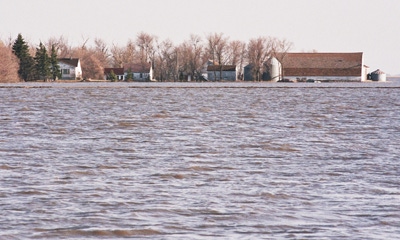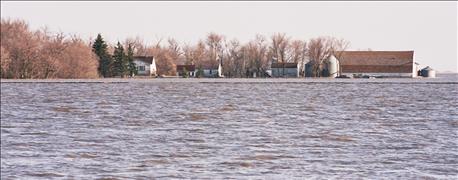October 14, 2016

Even though the Minnesota Department of Natural Resources denied a permit application for the proposed Fargo, N.D.-Moorhead, Minn. Flood Risk Management Project earlier this month, the U.S. Army Corps of Engineers said it will continue to pursue permanent flood risk management for those Red River Valley communities.
According to the DNR, its decision to deny the permit means the region’s Diversion Authority cannot proceed with the project as it is proposed.

FLOOD RISK MANAGEMENT CONTINUES: The U.S. Army Corps of Engineers said it will continue to work toward permanent flood risk management for the Red River Valley around Fargo, N.D. and Moorhead, Minn., despite the Minnesota Department of Natural Resources' denial of a permit for that effort.
The Minnesota permit for the dam portion of the $2.2 billion project was the last remaining major regulatory hurdle for the flood control plan. Construction was reportedly to begin later this fall on the 30-mile-long diversion channel that would redirect floodwater around the Fargo-Moorhead area, reducing the flood risk for more than 225,000 people and 70 square miles of infrastructure.
Still, the U.S. Army Corps of Engineers, St. Paul District, said in a press release it anticipates awarding its first contract for the project later this month.
Tom Landwehr, DNR commissioner, says agency staff identified several significant concerns about the proposed project in May, when the DNR published the Final Environmental Impact Statement for the proposal. Although the permit applicant developed a number of new provisions in response to DNR concerns, issues remain that have not been sufficiently addressed.
Landwehr says the state has an active program to help communities reduce their flood risk and agrees that enhanced flood protection is warranted for some places in the project area.
“However, the proposed project is not the right way to achieve that enhanced protection, and the project cannot be permitted under Minnesota law,” Landwehr says.
The DNR denied the permit application for three primary reasons, Landwehr notes:
1. The proposed project does not meet the requirement to be reasonable and practical, protect public safety and promote public welfare. Fifty-four percent of land removed from flooding is sparsely developed and rural. Fargo and Moorhead already have extensive flood protection infrastructure in place, with additional levees planned. Existing and planned infrastructure, in combination with emergency measures, is a minimal-impact solution to address flooding in Fargo and Moorhead during large floods and is thus more consistent with Minnesota law.
2. The project is not consistent with some state and local land use and water management plans in the project area. The concerns of affected upstream communities have not been addressed. The project is inconsistent with and undermines Minnesota policy and goals relating to floodplain management.
3. Mitigation, monitoring and adaptive management needs remain that have not been sufficiently addressed. Some potential impacts are anticipated to be severe and may be irreversible. The permit applicant’s funding source for mitigation, monitoring and adaptive management has not been determined or sufficiently detailed.
The proposed project would control flows through the Fargo-Moorhead metropolitan area via a dam and diversion channel system. Major project design features include two dams located upstream of the major population center, two embankments, a diversion channel, a 38,400-acre staging area, and in-town levees and floodwalls. The Red River dam would be classified as a Class I, or high-hazard, dam.
Minnesota Gov. Mark Dayton’s office issued a press release in response to the DNR’s decision.
“While 60% of the lands newly flooded by this project would be in Minnesota, we would receive only 14% of its benefits,” Dayton said. “North Dakota would receive 86% of the benefits while hosting only 40% of the newly flooded land.”
Corps moving ahead
Citing public safety as the main concern, the corps and the St. Paul District noted in a press release that more than 230,000 people live and work in the Fargo-Moorhead communities. A failed flood fight in the metro area could result in the loss of human life and $10 billion in damages. According to the corps, the Minnesota DNR denied the permit based on its belief that relying on emergency measures represents a feasible, prudent, and minimal-impact alternative to provide flood protection for the Fargo-Moorhead communities.
“Sandbagging should not be viewed as a long-term solution for any community and certainly not for the Fargo-Moorhead metropolitan area, where the Red River of the North has exceeded flood stage in 51 of the past 113 years,” says Col. Sam Calkins, St. Paul District commander. “The potential loss of life and economic devastation that would result from a failure of emergency measures are not acceptable risks.”
The corps did not apply for this permit and is not a party to the determination issued by the Minnesota DNR. However, corps staff said they are committed to continue working with Minnesota and all stakeholders to address remaining concerns, and to ensure the project is completed in a safe, environmentally sound manner.
The corps contract to be awarded will build the diversion inlet, located at the junction of the diversion channel and the southern embankment near Horace, N.D. No construction is planned in Minnesota until 2019. The corps can begin construction on the project in North Dakota while working with stakeholders to resolve any remaining issues.
More information on DNR’s position is available at dnr.state.mn.us/waters/fm-flood-risk.html.
Sources: DNR, U.S. Army Corps of Engineers
You May Also Like




